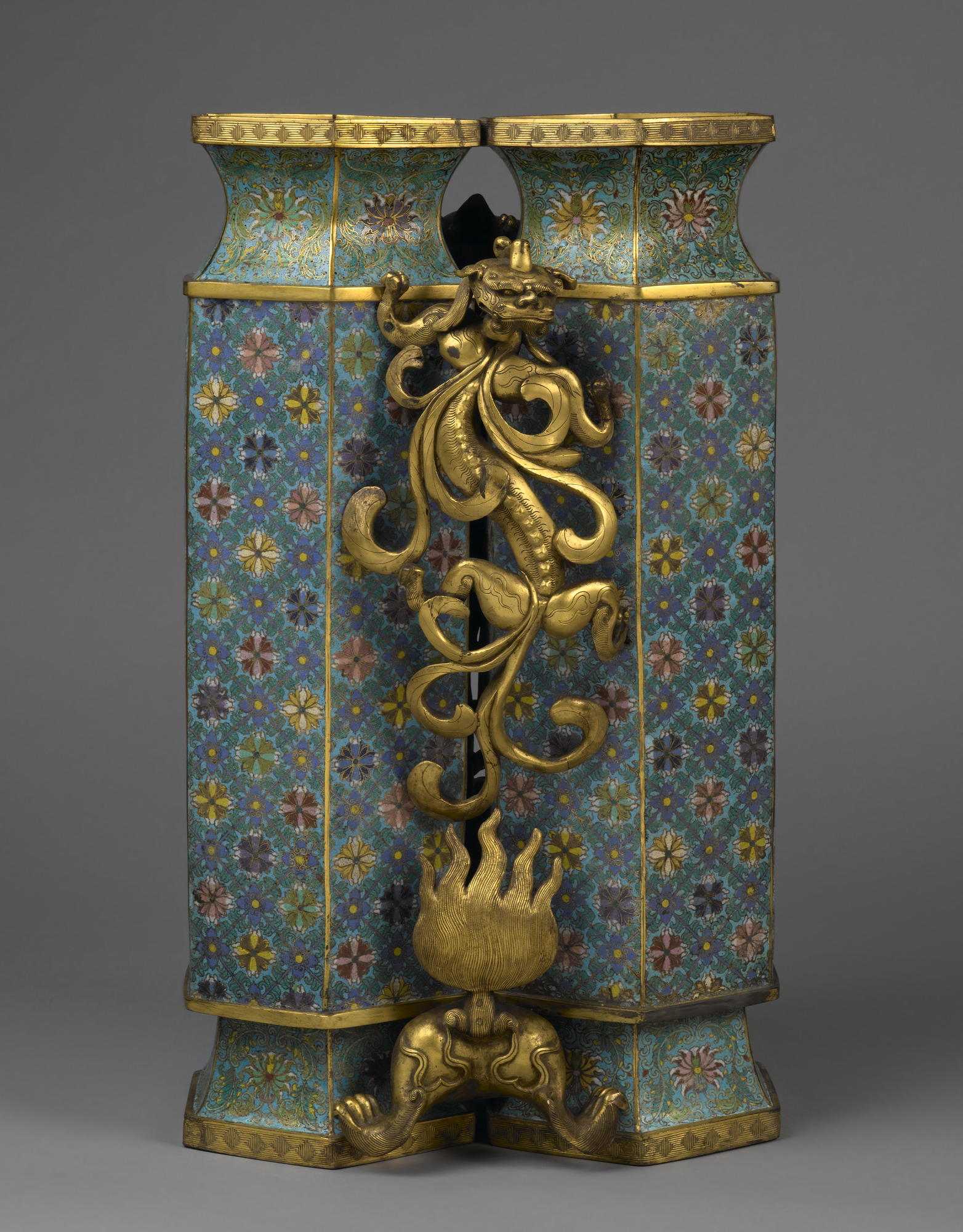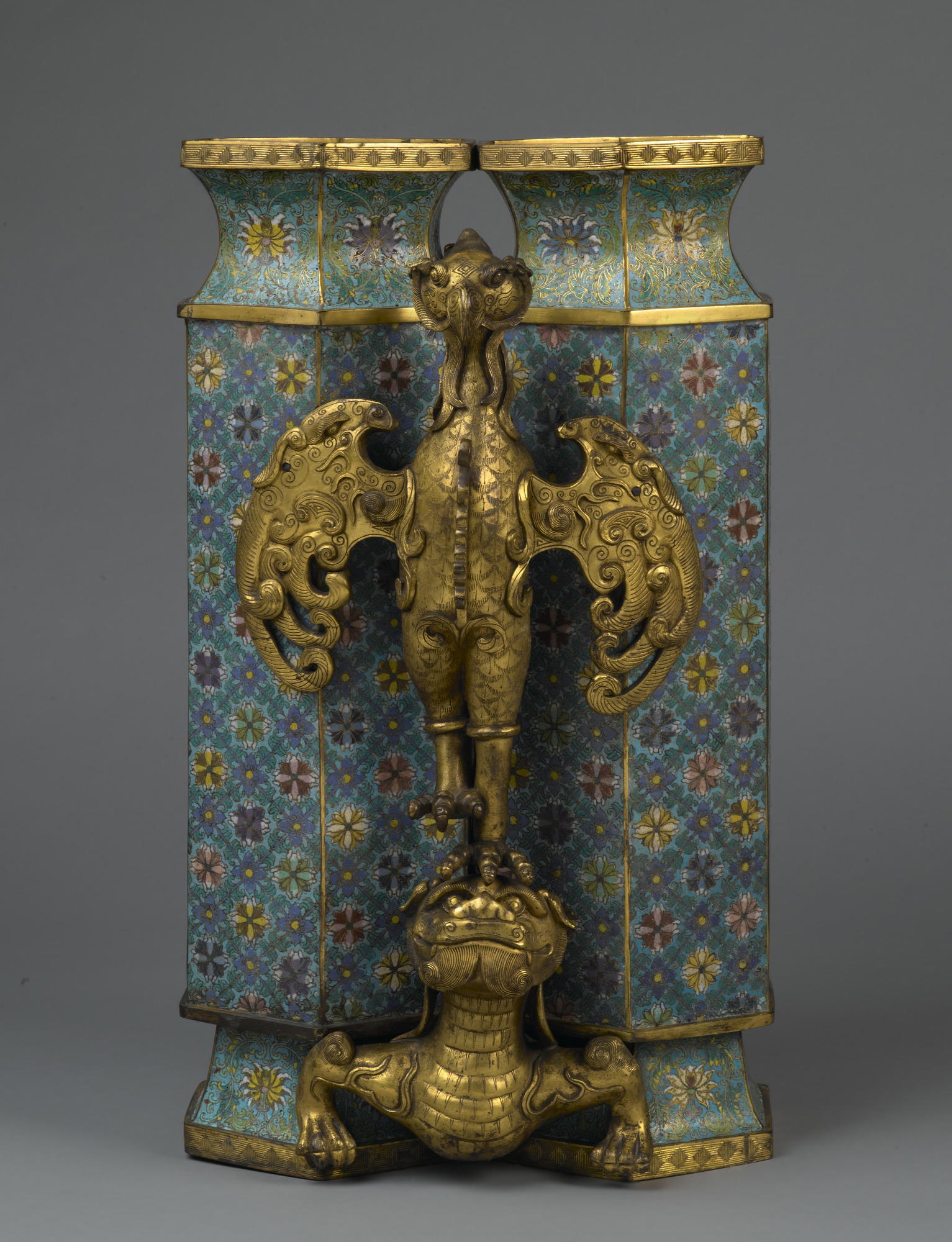Twin Vases with Carved Stand
1736–1795
1 of 2
Object Label
These joined twin vases were modeled on ancient bronze-arrow containers, given as rewards for military valor. On the front, a falcon—with outspread wings and one foot resting on the head of a monster—symbolizes courage, strength, and authority. The monster’s body passes between the bases of the vessels, and its flame-like tail is visible on the back, where it supports a dragon, the emblem of the emperor.
Caption
Twin Vases with Carved Stand, 1736–1795. Cloisonné enamel on copper alloy, gilt bronze, 25 1/4 x 15 x 13 in., 74.5 lb. (64.1 x 38.1 x 33 cm, 33.79kg). Brooklyn Museum, Gift of Samuel P. Avery, 09.606a-b. (Photo: Brooklyn Museum)
Collection
Collection
Title
Twin Vases with Carved Stand
Date
1736–1795
Dynasty
Qing Dynasty
Period
Qianlong Period
Geography
Place made: China
Medium
Cloisonné enamel on copper alloy, gilt bronze
Classification
Dimensions
25 1/4 x 15 x 13 in., 74.5 lb. (64.1 x 38.1 x 33 cm, 33.79kg)
Credit Line
Gift of Samuel P. Avery
Accession Number
09.606a-b
Frequent Art Questions
What is this?
 This impressive type of vessel is known as a Champion Vase. The name is a pun on the Chinese words for "falcon and bear." Champion vases combine two vessels that are joined by animals. In this case, it's a really elaborate bird standing on a monster!The two vessels are based on antique arrow containers. There was a huge interest in antiquity and reviving older shapes and styles in the Qing dynasty. During this time, books were published on the subject, which had illustrations of these ancient forms.Make sure you walk around the vessel! The back is pretty cool.Okay we did. Thank you!
This impressive type of vessel is known as a Champion Vase. The name is a pun on the Chinese words for "falcon and bear." Champion vases combine two vessels that are joined by animals. In this case, it's a really elaborate bird standing on a monster!The two vessels are based on antique arrow containers. There was a huge interest in antiquity and reviving older shapes and styles in the Qing dynasty. During this time, books were published on the subject, which had illustrations of these ancient forms.Make sure you walk around the vessel! The back is pretty cool.Okay we did. Thank you!Can you tell me about this?
 This vessel is known as a "champion vase." The name is a pun based on the Chinese words for "falcon" and "bear". These vases combine two vessels which are joined by an animal. In this case, there is a very elaborate bird perched on a monster.The form of the vessels in this piece is based on arrow containers. The technique used to apply the enamel on this piece is called "cloisonné". This technique entered China from the Middle East during the Yuan Dynasty. The result is spectacular.
This vessel is known as a "champion vase." The name is a pun based on the Chinese words for "falcon" and "bear". These vases combine two vessels which are joined by an animal. In this case, there is a very elaborate bird perched on a monster.The form of the vessels in this piece is based on arrow containers. The technique used to apply the enamel on this piece is called "cloisonné". This technique entered China from the Middle East during the Yuan Dynasty. The result is spectacular.What kind of animal is this?
 This is a dragon! Interestingly, in the Chinese tradition you can tell by how many toes are on the dragon whether an artwork was meant for the palace or not.The dragon was a symbol of the emperor, but because this one has less than five toes on each foot, we know that this vase did not belong to the emperor. Instead it was an award for a member of the military.
This is a dragon! Interestingly, in the Chinese tradition you can tell by how many toes are on the dragon whether an artwork was meant for the palace or not.The dragon was a symbol of the emperor, but because this one has less than five toes on each foot, we know that this vase did not belong to the emperor. Instead it was an award for a member of the military.Tell me more.
That's a lotus flower! One of the reasons this turquoise color may have been so popular is because it may have represented a watery setting for the lotus flower, itself a symbol of Buddhist enlightenment.
Have information?
Have information about an artwork? Contact us at

